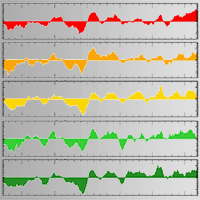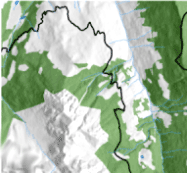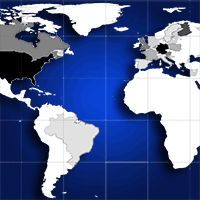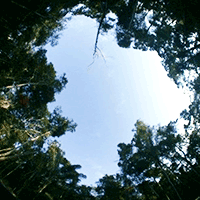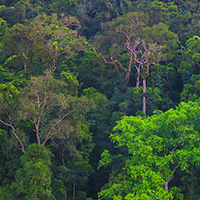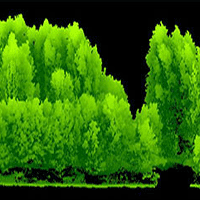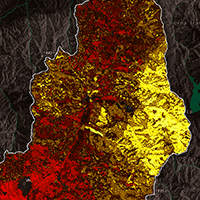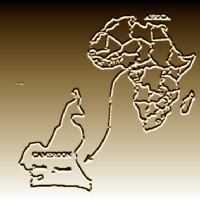Degradation, a reduction of the ecosystem’s capacity to supply goods and services, is widespread in tropical forests and mainly caused by human disturbance. To maintain the full range of forest ecosystem services and support the development of effective conservation policies, we must understand the overall impact of degradation on different forest resources. This research investigates the response to disturbance of forest structure using several indicators: soil carbon content, arboreal richness and biodiversity, functional composition (guild and wood density), and productivity. We drew upon large field and remote sensing datasets from different forest types in Ghana, characterized by varied protection status, to investigate impacts of selective logging, and of illegal land use and resources extraction, which are the main disturbance causes in West Africa. Results indicate that functional composition and the overall number of species are less affected by degradation, while forest structure, soil carbon content and species abundance are seriously impacted, with resources distribution reflecting the protection level of the areas. Remote sensing analysis showed an increase in productivity in the last three decades, with higher resiliency to change in drier forest types, and stronger productivity correlation with solar radiation in the short dry season. The study region is affected by growing anthropogenic pressure on natural resources and by an increased climate variability: possible interactions of disturbance with climate are also discussed, together with the urgency to reduce degradation in order to preserve the full range of ecosystem functions.
Keywords
, , , , ,
Citation
Vaglio Laurin G, Hawthorne WD, Chiti T, Di Paola A, Cazzolla Gatti R, Marconi S, Noce S, Grieco E, Pirotti F, Valentini R (2016). Does degradation from selective logging and illegal activities differently impact forest resources? A case study in Ghana. iForest 9: 354-362. - doi: 10.3832/ifor1779-008
Academic Editor
Matteo Garbarino
Paper history
Received: Jul 26, 2015
Accepted: Nov 06, 2015
First online: Jan 29, 2016
Publication Date: Jun 01, 2016
Publication Time: 2.80 months
© SISEF - The Italian Society of Silviculture and Forest Ecology 2016
Open Access
This article is distributed under the terms of the Creative Commons Attribution-Non Commercial 4.0 International (https://creativecommons.org/licenses/by-nc/4.0/), which permits unrestricted use, distribution, and reproduction in any medium, provided you give appropriate credit to the original author(s) and the source, provide a link to the Creative Commons license, and indicate if changes were made.

Breakdown by View Type
(Waiting for server response...)
Article Usage
Total Article Views: 54287
(from publication date up to now)
Breakdown by View Type
HTML Page Views: 43792
Abstract Page Views: 4507
PDF Downloads: 4669
Citation/Reference Downloads: 74
XML Downloads: 1245
Web Metrics
Days since publication: 3605
Overall contacts: 54287
Avg. contacts per week: 105.41
Article Citations
Article citations are based on data periodically collected from the Clarivate Web of Science web site
(last update: Mar 2025)
Total number of cites (since 2016): 27
Average cites per year: 2.70
Publication Metrics
by Dimensions ©
Articles citing this article
List of the papers citing this article based on CrossRef Cited-by.
(1)
Alder D, Synnott TJ (1992)Permanent sample plot techniques for mixed tropical forest. Tropical Forest Papers 25: 124-145.
Online |
Gscholar
(2)
Asase A, Asitoakor B, Ekpe P (2012)Linkages between tree diversity and carbon stocks in unlogged and logged West African tropical forests. International Journal of Biodiversity Science Ecosystem Services Management 8: 37-41.
CrossRef |
Gscholar
(3)
Batjes NH (2008)Mapping soil carbon stocks of Central Africa using SOTER. Geoderma 146: 58-65.
CrossRef |
Gscholar
(4)
Bedigian D (1998)Ecology of an African rain forest logging in Kibale and the conflict between conservation and exploitation. Economic Botany 52: 87-98.
CrossRef |
Gscholar
(5)
Blake GR, Hartge KH (1986)Bulk density In: “Methods of soil analysis: Part 1. Physical and mineralogical methods” (Klute A ed). Soil Science Society of America, American Society of Agronomy, Wisconsin, USA, pp. 363-375.
Gscholar
(6)
Blanc L, Echard M, Herault B, Bonal D, Marcon E, Chave J, Baraloto C (2009)Dynamics of aboveground carbon stocks in a selectively logged tropical forest. Ecological Applications 19: 1397-1404.
CrossRef |
Gscholar
(7)
Bongers F, Poorter L, Hawthorne WD, Sheil D (2009)The intermediate disturbance hypothesis applies to tropical forests but disturbance contributes little to tree diversity. Ecology letters 12: 798-805.
CrossRef |
Gscholar
(8)
Boone RD, Grigal DF, Sollins P, Ahrens RJ, Armstrong DE (1999)Soil sampling preparation archiving and quality control In: “Standard soil methods for long-term ecological research” (Robertson G, Coleman D, Bledsoe C, Sollins P eds). Oxford University Press, New York, USA, pp. 3-28.
Online |
Gscholar
(9)
Box GEP, Jenkins GM, Reinsel GC (2013)Time series analysis: forecasting and control. John Wiley and Sons, Hoboken, New Jersey, USA, pp. 598.
Online |
Gscholar
(10)
Carreño-Rocabado G, Peña-Claros M, Bongers F, Alarcón A, Licona J-C, Poorter L (2012)Effects of disturbance intensity on species and functional diversity in a tropical forest. Journal of Ecology 100: 1453-1463.
CrossRef |
Gscholar
(11)
Cazzolla Gatti R, Castaldi S, Lindsell J, Coomes D, Marchetti M, Maesano M, Di Paola A, Paparella F, Valentini R (2015)The impact of selective logging and clearcutting on forest structure tree diversity and above-ground biomass of African tropical forests. Ecological Research 30: 119-132.
CrossRef |
Gscholar
(12)
CEPF (2003)Guinean forests of West Africa biodiversity hotspot: upper Guinean forest briefing book. Critical Ecosystem Partnership Fund, Washington DC, USA, pp. 51.
Gscholar
(13)
Chao A (1984)Nonparametric estimation of the number of classes in a population. Scandinavian Journal of Statistics 11: 265-270.
Online |
Gscholar
(14)
Chao A, Shen TJ (2003)Nonparametric estimation of Shannon’s index of diversity when there are unseen species in sample. Environmental and Ecological Statistics 10 (4): 429-443.
CrossRef |
Gscholar
(15)
Chave J, Andalo C, Brown S, Cairns MA, Chambers JQ, Eamus D, Fölster H, Yamakura T (2005)Tree allometry and improved estimation of carbon stocks and balance in tropical forests. Oecologia 145: 87-99.
CrossRef |
Gscholar
(16)
Chave J, Coomes D, Jansen S, Lewis SL, Swenson NG, Zanne AE (2009)Towards a worldwide wood economics spectrum. Ecology Letters 12: 351-366.
CrossRef |
Gscholar
(17)
Chiti T, Grieco E, Perugini L, Rey A, Valentini R (2014)Effect of the replacement of tropical forests with tree plantations on soil organic carbon levels in the Jomoro district Ghana. Plant and Soil 375: 47-59.
CrossRef |
Gscholar
(18)
Coleman BD, Mares MA, Willig MR, Hsieh YH (1982)Randomness area and species richness. Ecology 63: 1121-1133.
CrossRef |
Gscholar
(19)
Damnyag L, Saastamoinen O, Blay D, Dwomoh FK, Anglaaere LC, Pappinen A (2013)Sustaining protected areas: identifying and controlling deforestation and forest degradation drivers in the Ankasa Conservation Area in Ghana. Biological Conservation 165: 86-94.
CrossRef |
Gscholar
(20)
Dong SX, Davies SJ, Ashton PS, Bunyavejchewin S, Supardi MNN, Kassim AR, Tan S, Moorcroft PR (2012)Variability in solar radiation and temperature explains observed patterns and trends in tree growth rates across four tropical forests. Proceedings of the Royal Society B: Biological Sciences 279: 3923-3931.
CrossRef |
Gscholar
(21)
Ewel JJ (1977)Differences between wet and dry successional tropical ecosystems. GeoEcoTrop 1: 103-117.
Gscholar
(22)
FAO (1998)Country profile: Ghana. FID/CP/GHA Rev 3, Food and Agriculture Organization of the United Nations, Rome, Italy, pp. 37.
Gscholar
(23)
FAO (2006)Global forest resources assessment 2005. Progress towards sustainable forest management. FAO Forestry Paper no 147, Food and Agriculture Organization of the United Nations, Rome, Italy, pp. 321.
Gscholar
(24)
Fauset S, Baker TR, Lewis SL, Feldpausch TR, Affum-Baffoe K, Foli EG, Hamer KC, Swaine MD (2012)Drought-induced shifts in the floristic and functional composition of tropical forests in Ghana. Ecology Letters 15: 1120-1129.
CrossRef |
Gscholar
(25)
Feng X, Porporato A, Rodriguez-Iturbe I (2013)Changes in rainfall seasonality in the tropics. Nature Climate Change 3: 811-815.
CrossRef |
Gscholar
(26)
Gibson L, Lee TM, Koh LP, Brook BW, Gardner TA, Barlow J, Peres CA, Bradshaw CJA, Laurance WF, Lovejoy TE, Navjot S (2011)Primary forests are irreplaceable for sustaining tropical biodiversity. Nature 478: 378-381.
CrossRef |
Gscholar
(27)
Gotelli NJ, Colwell RK (2001)Quantifying biodiversity: Procedures and pitfalls in the measurement and comparison of species richness. Ecology Letters 4: 379-391.
CrossRef |
Gscholar
(28)
Graham EA, Mulkey SS, Kitajima K, Phillips NG, Wright SJ (2003)Cloud cover limits net CO
2 uptake and growth of a rainforest tree during tropical rainy seasons. PNAS 100: 572-576.
CrossRef |
Gscholar
(29)
Hall JB, Swaine MD (1976)Classification and ecology of closed-canopy forest in Ghana. Journal of Ecology 64: 913-1001.
CrossRef |
Gscholar
(30)
Hall JB, Swaine MD (1981)Distribution and ecology of vascular plants in a tropical rain forest: forest vegetation in Ghana. Springer Netherlands, Dordretch, The Netherlands, pp. 383.
Online |
Gscholar
(31)
Hall JS, Harris DJ, Medjibe V, Ashton PMS (2003)The effects of selective logging on forest structure and tree species composition in a Central African forest: implications for management of conservation areas. Forest Ecology and Management 183: 249-264.
CrossRef |
Gscholar
(32)
Hansen CP, Damnyag L, Obiri BD, Carlsen K (2012)Revisiting illegal logging and the size of the domestic timber market: the case of Ghana. International Forestry Review 14: 39-49.
CrossRef |
Gscholar
(33)
Harris I, Jones PD, Osborn TJ, Lister DH (2014)Updated high-resolution grids of monthly climatic observations - the CRU TS310 Dataset. International Journal of Climatology 34: 623-642.
CrossRef |
Gscholar
(34)
Hawthorne WD (1993)Forest regeneration after logging: findings of a study in the Bia South Game Production Reserve in Ghana. ODA Forestry Series 3: 52-65.
Online |
Gscholar
(35)
Hawthorne WD (1995)Ecological profiles of Ghanaian forest trees. Tropical Forestry Papers no 29, Oxford Forestry Institute, Oxford, UK, pp. 345.
Online |
Gscholar
(36)
Hawthorne WD (1996)Holes and the sums of parts in Ghanaian forest: regeneration scale and sustainable use. Proceedings of the Royal Society of Edinburgh Section B - Biological Sciences 104: 75-176.
CrossRef |
Gscholar
(37)
Hawthorne W, Abu-Juam M (1995)Forest protection in Ghana with particular reference to vegetation and plant species. International Union for Conservation of Nature, Gland, Switzerland, pp. 202.
Online |
Gscholar
(38)
Hawthorne WD, Sheil D, Agyeman VK, Abu Juam M, Marshall CM (2012)Logging scars in Ghanaian high forest: towards improved models for sustainable production. Forest Ecology and Management 271: 27-36.
CrossRef |
Gscholar
(39)
Henry M, Valentini R, Bernoux M (2009)Soil carbon stocks in ecoregions of Africa. Biogeosciences Discussions 6: 797-823.
CrossRef |
Gscholar
(40)
Heubes J, Kühn I, König K, Wittig R, Zizka G, Hahn K (2011)Modelling biome shifts and tree cover change for 2050 in West Africa. Journal of Biogeography 38: 2248-2258.
CrossRef |
Gscholar
(41)
Hirsch RM, Slack JR (1984)A nonparametric trend test for seasonal data with serial dependence. Water Resources Research 20: 727-732.
CrossRef |
Gscholar
(42)
Hollander M, Wolfe D (1973)Nonparametric statistical methods. John Wiley and Sons, New York, USA, pp. 848.
Gscholar
(43)
Huang M, Asner GP (2010)Long-term carbon loss and recovery following selective logging in Amazon forests. Global Biogeochemical Cycles 24: GB3028. -
Online |
Gscholar
(44)
Ibrahima A, Mvondo ZE, Ntonga JC (2010)Fine root production and distribution in the tropical rainforests of south-western Cameroon: effects of soil type and selective logging. iForest 3: 130-136.
CrossRef |
Gscholar
(45)
IUCN (2010)Parks and reserves of Ghana: management effectiveness assessment of protected areas. International Union for Conservation of Nature, Gland, Switzerland, pp. 56.
Gscholar
(46)
Lanly J (1981)Manual of forest inventory; with special reference to mixed tropical forests. FAO Forestry Paper 27, FAO, Rome, Italy, pp. 200.
Gscholar
(47)
Lewis SL, Lopez-Gonzalez G, Sonké B, Affum-Baffoe K, Baker TR, Ojo LO, Phillips OL, Reitsma JM, White L, Wöll H (2009)Increasing carbon storage in intact African tropical forests. Nature 457: 1003-1006.
CrossRef |
Gscholar
(48)
Liebsch D, Marques MCM, Goldenberg R (2008)How long does the Atlantic rain forest take to recover after a disturbance? Changes in species composition and ecological features during secondary succession. Biological Conservation 141: 1717-1725.
CrossRef |
Gscholar
(49)
Li Y, Xia Y, Lei Y, Deng Y, Chen H, Sha L, Cao M, Deng X (2015)Estimating changes in soil organic carbon storage due to land use changes using a modified calculation method. iForest 8: 45-52.
CrossRef |
Gscholar
(50)
Lindsell JA, Klop E (2013)Spatial and temporal variation of carbon stocks in a lowland tropical forest in West Africa. Forest Ecology and Management 289: 10-17.
CrossRef |
Gscholar
(51)
Magurran AE (2004)Measuring biological diversity. African Journal of Aquatic Science 29: 285-286.
CrossRef |
Gscholar
(52)
Margalef DR (1958)Information theory in ecology. Year-book of the Society for General Systems Research 3: 36-71.
Gscholar
(53)
McCune B, Mefford M (2011)PC-ORD. Multivariate analysis of ecological data (version 6). MjM Software, Gleneden Beach, Oregon, USA, pp. 28.
Online |
Gscholar
(54)
MEA (2005)Ecosystems and human well-being: current state and trends. Island Press, Washington, DC, USA, pp. 917.
Gscholar
(55)
Molino JF, Sabatier D (2001)Tree diversity in tropical rain forests: a validation of the intermediate disturbance hypothesis. Science 294: 1702-1704.
CrossRef |
Gscholar
(56)
Mulkey SS, Kitajima K, Wright SJ (1996)Plant physiological ecology of tropical forest canopies. Trends in Ecology Evolution 11: 408-412.
CrossRef |
Gscholar
(57)
Murphy PG, Lugo AE (1986)Ecology of tropical dry forest. Annual Review of Ecology and Systematics 17: 67-88.
CrossRef |
Gscholar
(58)
Nemani RR, Keeling CD, Hashimoto H, Jolly WM, Piper SC, Tucker CJ, Myneni RB, Running SW (2003)Climate-driven increases in global terrestrial net primary production from 1982 to 1999. Science 300: 1560-1563.
CrossRef |
Gscholar
(59)
Norris K, Asase A, Collen B, Gockowksi J, Mason J, Phalan B, Wade A (2010)Biodiversity in a forest-agriculture mosaic-the changing face of West African rainforests. Biological Conservation 143: 2341-2350.
CrossRef |
Gscholar
(60)
Owusu K, Waylen P (2009)Trends in spatio-temporal variability in annual rainfall in Ghana (1951-2000). Weather 64: 115-120.
CrossRef |
Gscholar
(61)
Paeth H, Hall NMJ, Gaertner MA, Alonso MD, Moumouni S, Polcher J, Ruti PM, Fink AH, Gosset M, Rummukainen M (2011)Progress in regional downscaling of west African precipitation. Atmospheric Science Letters 12: 75-82.
CrossRef |
Gscholar
(62)
Pau S, Wolkovich EM, Cook BI, Nytch CJ, Regetz J, Zimmerman JK, Wright S (2013)Clouds and temperature drive dynamic changes in tropical flower production. Nature Climate Change 3: 838-842.
CrossRef |
Gscholar
(63)
Pirotti F (2010)Assessing a template matching approach for tree height and position extraction from lidar-derived canopy height models of
Pinus Pinaster stands. Forests 1: 194-208.
CrossRef |
Gscholar
(64)
Pirotti F (2011)Analysis of full-waveform LiDAR data for forestry applications: a review of investigations and methods. iForest 4: 100-106.
CrossRef |
Gscholar
(65)
Poorter L, Hawthorne W, Bongers F, Sheil D (2008)Maximum size distributions in tropical forest communities: relationships with rainfall and disturbance. Journal of Ecology 96: 495-504.
CrossRef |
Gscholar
(66)
Ramcilovic-Suominen S, Gritten D, Saastamoinen O (2010)Concept of livelihood in the FLEGT voluntary partnership agreement and the expected impacts on the livelihood of forest communities in Ghana. International Forestry Review 12: 361-369.
CrossRef |
Gscholar
(67)
Sasaki N, Asner GP, Knorr W, Durst PB, Priyadi HR, Putz FE (2011)Approaches to classifying and restoring degraded tropical forests for the anticipated REDD+ climate change mitigation mechanism. iForest 4: 1-6.
CrossRef |
Gscholar
(68)
Santoro F, Tarantino E, Figorito B, Gualano S, D’Onghia AM (2013)A tree counting algorithm for precision agriculture tasks. International Journal of Digital Earth 6 (1): 94-102.
CrossRef |
Gscholar
(69)
Silverman B (1986)Density estimation for statistics and data analysis. Chapman and Hall/CRC, Boca Raton, FL, USA, pp. 171.
Gscholar
(70)
Sokal RR, Rohlf FJ (1995)Biometry: the principles and practice of statistics in biological research. Freeman, San Francisco, USA, pp. 776.
Gscholar
(71)
Wang J, Dong J, Liu J, Huang M, Li G, Running SW, Smith WK, Harris W, Saigusa N, Kondo H, Xiao X (2014)Comparison of gross primary productivity derived from GIMMS NDVI3g GIMMS and MODIS in Southeast Asia. Remote Sensing 6: 2108-2133.
CrossRef |
Gscholar
(72)
Yanai RD, Currie WS, Goodale CL (2003)Soil carbon dynamics after forest harvest: an ecosystem paradigm reconsidered. Ecosystems 6: 197-212.
CrossRef |
Gscholar
(73)
Zhu L, Southworth J (2013)Disentangling the relationships between net primary production and precipitation in Southern Africa savannas using satellite observations from 1982 to 2010. Remote Sensing 5: 3803-3825.
CrossRef |
Gscholar
(74)
Zhu Z, Bi J, Pan Y, Ganguly S, Anav A, Xu L, Samanta A, Piao S, Nemani RR, Myneni RB (2013)Global data sets of vegetation leaf area index (LAI) 3g And fraction of photosynthetically active radiation (FPAR) 3g derived from global inventory modeling and mapping studies (GIMMS) normalized difference vegetation index (NDVI3g) for the period 1981 to 2011. Remote Sensing 5: 927-948.
CrossRef |
Gscholar
